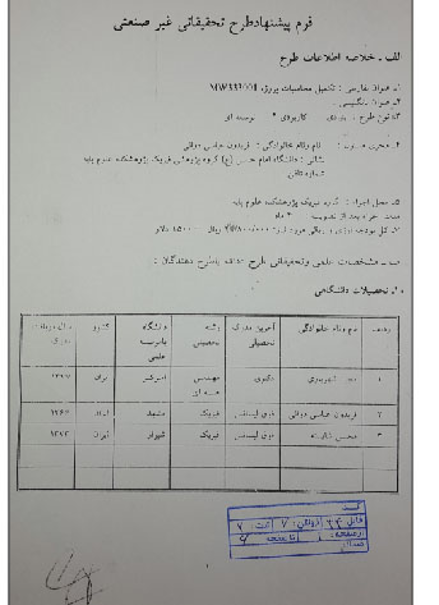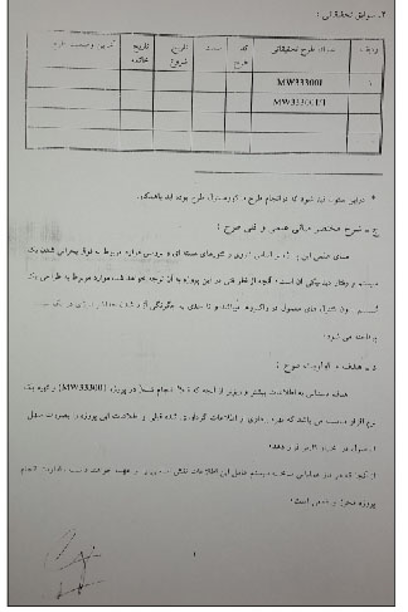Reports
Iran’s Early Development of Nuclear Weapons Codes— An Example from the Nuclear Archive of a Project Proposal at Imam Hussein University
by David Albright and Mark Gorwitz
February 18, 2020
Based on a recently obtained Farsi document from the Iranian Nuclear Archive, believed to date to the late 1990s or early 2000s, Iran’s theoretical work on nuclear weapons was aided by studies of certain transient phenomena in nuclear reactor accidents, a practice other countries employed in developing nuclear weapons. Understanding and modifying these readily available reactor codes allows a nuclear weapons program to study the brief period of time when a reactor core undergoes a rapid rise in power and then disassembles, i.e. “the reactor runs away,” another way of providing an unclassified starting point for studying the dynamic simulation of a nuclear explosion. This approach, for example, was extensively utilized by Taiwan’s nuclear weapons program, allowing first the development of its first implosion-type nuclear weapons codes, later a method for improving these weapons codes.1
The new document from the Nuclear Archive is an undated Iranian research proposal, titled “Proposal for Non-Industrial Research Project,” submitted by project leader Fereydoun Abbasi-Davani.2 Figure 1 shows images of the first two pages of the proposal. He lists his address and the location of the project as the Physics Research Group, Imam Hussein University. Abbasi-Davani has been linked by several documents in the Nuclear Archive to Iran’s nuclear weapons program in the early 2000s, establishing him as a senior leader of Iran’s nuclear weapons program. In 2012, Imam Hussein University was added to the Specially Designated Nationals List, Office of Foreign Assets Control, U.S. Treasury.
The proposal summarizes the project’s scientific and technical principles:
The principles of the project are based on nuclear reactor theories. It will examine issues related to turning the system into a super-critical system and the system’s dynamic behavior. The technical issues this project will focus on involve designing a system without the control measures commonly used in reactors, and involve releasing maximum energy.
The project’s importance is noted in the proposal, “Since this information will play a key role in the operational stage of the operating system, the importance of this project is clear” (emphasis added). The term operating system is the code word often used in the Nuclear Archive, designating at times the nuclear explosive device and other times the program to build such a device. For example, an organizational chart of Project 110 of the Amad Plan from the archive lists the operating system project as one of four key tasks in building deliverable nuclear weapons (see Figure 2).3


Figure 1. First two pages of a six-page proposal for a study related to developing nuclear weapon computer codes at Imam Hussein University. Page 1 is on left, and page 2 is on right. The project was expected to last for four months and be located at Imam Hussein University’s Core Sciences Research Institute, Physics Research Group. The total requested budget was 30.8 million rial and $1,500 in foreign currency (see below). The latter was for purchasing unidentified software abroad. The signature could not be read; the blue stamp is typical of those used by Iran to identify documents in the archive.
In addition to Abbasi-Davani, the project involved two other professors, Majid Shahriari, and Mohsen Shayesteh. Both Abbasi-Davani and Shayesteh list their field of education as physics, Shahriari lists nuclear engineering.
Shahriari has also been named in archive documents as a senior member of Iran’s nuclear weapons program. Shayesteh could not be linked directly to Iran’s nuclear weapons program, , but his later scientific publications suggest his importance to this project lay in his expertise in understanding, designing, and running nuclear reactor-related software. Some of his later, post-Amad scientific publications in the area of neutron transport and behavior in fissionable material involved both Shayesteh and Shahriari, where Shayesteh was listed as the primary author.
The proposal states that all three worked on earlier research projects in this area, called MW333001 and MW333001/1. Furthermore, the proposal makes clear that this project is a continuation of the earlier effort with the goal of obtaining “additional, more detailed information on the activity carried out [in an earlier project] and obtain suitable software in order to facilitate the use of past information and information from this project.”
Although the proposal is undated, it appears to cover work done after 1998 but before early 2002. The 1998 date is given on the proposal as the date when Shahriari received his PhD from Amir Kabir University. The total cost of the project would suggest that it was performed by early 2002, when the value of Iran’s rial started to decline significantly.
As mentioned above, Abbasi-Davani requested a total of 30.8 million rial and $1,500 in foreign currency. Prior to March 2002, the official rate for state entities was fixed at about 1,500 rials to the dollar, implying that the 30.8 million rial converts to about $20,600. This value seems low, but credible for a four-month project in Iran aiming to finish up and extend earlier work.
Abbasi-Davani also included the following information in the proposal:
Scientific, research, and bibliography methodologies to be used for the project:
The theoretical points of the previous project should be researched, and the problems should be resolved. To carry out the new task, the problems have to be defined, the new output has to be generated, and the results have to be analyzed. Future calculations should be carried out in accordance with the results. The work has to be summarized, and suitable software should be written.
Planning experience in Iran and elsewhere; how previous research is connected to the current project:
Only the previous project is available to us.
However, the know-how is available in other countries, but is not accessible due to classification. The current project will continue and complete the previous project (MW333001).
Organizations or institutes that will assist you in carrying out the project:
a. Atomic Energy Organization; nature of cooperation: Use of scientific resources
b. The physics center at the MOD’s training and research institute; nature of the cooperation: Use of scientific resources
The proposal contains a Gantt diagram for implementing the project over a four-month period, where the major tasks are the following:
- Correcting and completing calculation regarding the beryllium reflector
- Completing calculation regarding the force of the explosion based on the fuel mass.
- Carrying out dynamic calculations for one or two low enrichments
- Checking the effect of the neutron source on the explosion dynamics
- Summary of the calculations carried out
- Planning the section headings of the software and writing it
- Preparing a final report
Findings and Recommendations
The document demonstrates that Imam Hussein University was involved in nuclear weapons work, hosting at least two key members of Iran’s nuclear weapons program, namely Abbasi-Davani and Shahriari. Shayesteh may have been important in designing and running nuclear weapons codes.
This type of project would not be surprising in Iran’s nuclear weapons program, likely occurring earlier in its effort, when nuclear weapons codes were being developed. It is not unusual for such a project to seek—and likely obtain—unclassified, but possibly export controlled, reactor accident codes overseas. Moreover, the Physics Research Center (PHRC), the predecessor to the Amad program, had obtained abroad a series of nuclear reactor codes, all of which were available publicly but could be modified to model nuclear weapons behavior. This project may have built on that earlier work.
There is no reason to believe the project did not happen. Or if this specific one did not finish, another one accomplished the task. Project 110 of the Amad Plan finished designing a nuclear explosive, where Project 110’s operating system project had both a nuclear calculation group and a hydrodynamic calculation group (see Figure 2). Moreover, Project 110 had a simulation project with both software and hardware groups.
Nonetheless, a priority is learning this project’s accomplishments and Iran’s subsequent work to improve its nuclear weapons codes. An unanswered question is whether this work continues today, helping Iran maintain a readiness to build nuclear weapons, if it decided to do so.
Organizational Chart of Project 110, Amad Supraorganizational Plan

Figure 2. Translation of a Nuclear Archive chart depicting the organizational structure of Project 110, showing its four main components (in red): the Warhead, Midan, Operating System, and Simulation projects. The Warhead project was charged with fitting the nuclear warhead into the re-entry vehicle of a Shahab-3 ballistic missile, including fusing, arming, and firing mechanisms. The Midan project was responsible for creating a nuclear test site for a 10 kiloton detonation and methods to estimate the yield of a nuclear detonation. The Operating System project was charged with the task of creating a complex to design, develop, and build a nuclear warhead. The Nuclear Calculation and Hydrodynamic Calculation Groups are listed under the Operating System project. https://isis-online.org/isis-reports/detail/from-irans-nuclear-archive-organizational-chart-of-project-110-amad-supraor/ Translator’s notes: Commander can also be translated as commissioner. The extra white lines on the mid-left of the chart are from the original diagram.
1. David Albright and Andrea Stricker, Taiwan’s Former Nuclear Weapons Program (Washington, DC, Institute for Science and International Security Press, 2018). One example excerpted and shortened from the book involves an early nuclear weapons effort in the 1960s to modify a U.S. unclassified reactor safety code called AX1, which Taiwan had obtained from a “friend” in the United States. The circuitous procurement process may have reflected that the code was covered by U.S. export controls, which would have likely blocked its legitimate transfer to Taiwan. With the code in hand, Taiwan’s nuclear experts proceeded to modify it for nuclear explosions. They concentrated on modifying the code for calculating the dynamics of an implosion system, in particular the simulation of nuclear weapon assembly explosion sequences and the estimation of the explosive yield. ↩
2. This report uses an English translation of the document which was provided to the Institute. An Institute translator conducted a preliminary comparison between the Farsi document and the provided English translation and found no major discrepancies. ↩
3. From Iran’s Nuclear Archive: Organizational Chart of Project 110, Amad Supraorganizational Plan, https://isis-online.org/isis-reports/detail/from-irans-nuclear-archive-organizational-chart-of-project-110-amad-supraor/ ↩

 twitter
twitter